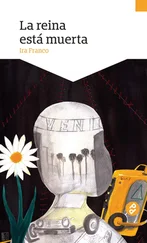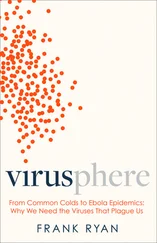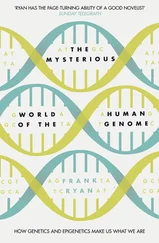He said: ‘It’s a very interesting question.’
We talked about how viruses could change the behaviour and internal chemistry of bacteria, for example by making them resistant to antibiotics. The diphtheria bacterium produced a poison, known as a toxin, which was entirely dependent on the presence of a virus within the bacterium.
So it was that our conversation moved round a topic that we both recognised as extremely important, if potentially very controversial.
I explained what I had learnt from the scientists investigating the hantavirus epidemic, for example the fact that baby deer mice are born without the virus. They acquired it as weanlings, from copious secretions of the virus in the urine and other excreta of the mother. Yet when they acquired this virus, which was so horribly lethal to people, they showed no sign of illness. It was as if, in first meeting the virus when their immune systems were just coming to recognise self from alien, they came to regard the virus as self. In fact, some of the biologists working on the virus-mouse interaction had the feeling that the baby mice grew bigger, stronger, as a result of the presence of the virus. I took a breath and asked the question that had preoccupied my thoughts for the last two months.
‘I know that viruses don’t think. They don’t have a concept of good or bad – they’re not just immoral but amoral. But is it possible a virus could have a beneficial effect on an animal species?’ I should have known better than to use the word “beneficial”, since it is loaded with anthropomorphic overtones. What I meant, and should have asked, was if the presence of a virus might help the host survive.
‘Well, that would be interesting … I don’t know of a clear example of any such mutualistic advantage, but it’s on the cards. And if nothing else, cross-immunity to other infecting agents is certainly going to come into the picture. But I just don’t happen to have it at my fingertips for animals.’
I pushed it a little further. ‘I find myself asking the question, could a viral infection in a species change that species – could it go so far as to create a new species?’
It was probably the most challenging question I put to him, and it resulted in another of those telling pauses.
‘I can commend a book to you that has just come out. It answers the somewhat larger questions. It is by Jan Sapp and it covers symbiosis – the history of the concept. 6Jan is a historian of science from York University, in Canada. He was a visiting scholar here in my laboratory when he wrote the book. He’s been following the thinking of Lynn Margulis, who is probably the most articulate person on this line of thinking. You might have seen something of her writings. Where symbiosis leads to the convergence of two genomes from disparate sources, making, if you like, a very wide hybrid, it becomes the source of evolutionary change of the most major implications. There is a fair consensus now that this is how the eukaryotic cell evolved.’
The eukaryotic cell is a cell with a nucleus. The evolution of such a cell from humble bacterial forebears gave rise to all of the animals, plants, fungi, algae and smaller creatures, such as the amoebae of my school biology days. That same evolutionary step had been extolled by the eminent Darwinian, Ernst Mayr, as the single most important step in the evolution of life. If my interview with Terry Yates had first opened my eyes to the possibility of a new vision of viruses and their role in evolution, this interview with Joshua Lederberg had further encouraged that vision. I left New York more determined than ever to examine it further.
In the opening chapter I outlined a three-way symbiotic relationship between the sea slug Elysia chlorotica , its host alga, and an unknown, virus, putatively a retrovirus, that has entered into a persistent relationship with the slug. But back in 1994 I knew nothing about Elysia , and its relationship with the virus was poorly understood. The truth is that I was in the dark as far as symbiosis was concerned. I had no idea how this biological condition called symbiosis was defined. Did symbiosis imply a different evolutionary mechanism from the highly respected modern Darwinism? My conversation with Lederberg suggested that there were important differences between the two evolutionary disciplines, yet there was no hint that he felt these differences negated the conventional viewpoint. I was mindful of his words of advice: ‘You just need some scaffold to begin your thinking.’ My scaffold would be the biological discipline of symbiosis, and its many examples and operative mechanisms, focusing in particular on how symbiologists – the people who study symbiosis – figured that symbiosis operated as an evolutionary force.
Readers of Jan Sapp’s landmark history of symbiosis will discover how, in 1868, some nine years after Darwin had published The Origin of Species , a Swiss botanist, Simon Schwendener, made a curious discovery about the biological nature of lichens. We are familiar with lichens as the flat, pastel-shaded growths that decorate tombstones or the historic boulders of Stonehenge, but they are far more varied and ubiquitous than the cursory familiarity would suggest. They play an important role in the world’s ecology as pioneer organisms, thriving in inclement environments, such as sand-dunes or the windswept valleys of Antarctica, where they eke out a living on the exposed surfaces, breaking stone down into soil, or soaking up useful reservoirs of water from ambient dew or fog in forest ecologies. In this way, lichens create specialised ecosystems from which other life forms can benefit, for example the hardy growths that endure beneath the Arctic snow providing the main food source for the Sami’s reindeer. At the time of Schwendener’s discovery, lichens had only recently been slotted into place on the biological tree of life as a branch, in the jargon a “class”, of their own coming off the main trunk, or “kingdom”, of the plants, with naturalists devoting their time and energies to defining more than a thousand species that formed the twigs and leaves of that branch. Now, all of a sudden, such endeavour and certainty was thrown to the four winds when Schwendener demonstrated that lichens were not individual organisms at all but intimate associations of two radically different life forms, an alga and a fungus.
Since the time of Swedish naturalist, Carl Linnaeus, in the eighteenth century, biologists had assumed that all living organisms were discrete individuals, which existed as members of a species, which could be accurately assigned to its precise twig and leaf on the tree of life. We humans, for example, belong to the species sapiens , within the genus Homo , which is attached to the branchlet, or “order”, of primates, within the branch, or “class”, of mammals. But now it would appear that, rather than constituting any branch, or twig, or leaf, on the tree of life, lichens comprised an intimate intertwining of two of the main trunks – the kingdoms of the protists and fungi. For the orderly world of Victorian naturalists, the implications were devastating. Many lichenists refused to believe it and they roundly dismissed any such dualistic notions as an “abomination” that sowed confusion in place of order.
But despite the resistance, which endured in some quarters for almost half a century, study of the dual nature of lichens grew and spread, with some biologists, and botanists in particular, realising that lichens might not be the only example of an important association, or partnership, between very different living beings. This brought into sharp focus the concept of parasitism.
It was clear, from lichens, that the traditional idea of parasitism was inadequate to explain the real complexity of what studies were now revealing of the very close interdependency of the fungi and algae that made up the diverse group. Other examples of intimate interdependency of different life forms were duly recognised, from the coral reefs to forest oaks. In time the German botanist, Albert Bernhard Frank, would discover that virtually every plant was in partnership with a variety of fungi that fed into it, often physically invading the roots, so much so that the familiar root ball we shake out of its pot from the garden centre is largely fungus. The plant above ground supplies carbon compounds and energy to the fungus, while the fungus feeds water and minerals into the root. In the 17,000 or so species of orchids the relationship was so intimate that the fungus was found to supply the sprouting seed with carbon as well as water and electrolytes. The growing biological field demanded a formal name and definition and these were duly provided by another German botanist, Anton de Bary, who, in 1878, coined the term “symbiosis”, which he defined as “the living together of different organisms”. 7The definition was designed to embrace the many different associations already known to take place in nature, including parasitism, in which one of the partners gained at the expense of another, commensalism, where a partner gained without harming another, and mutualism, where more than one partner was seen to benefit from the relationship. The interacting partners became known as “symbionts” and the partnership, holistically, became known as the “holobiont”.
Читать дальше












